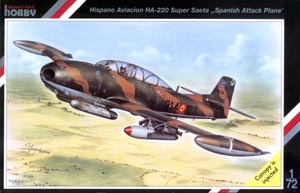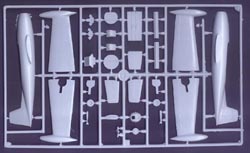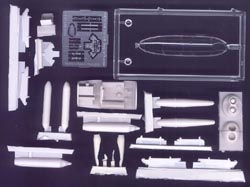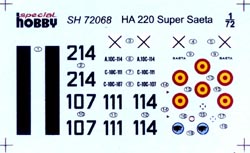Special Hobby 1/72 Hispano Aviacion HA-220 Super
Saeta
|
 |
History
The Hispano HA-220 Super Saeta was developed from the HA-200 trainer
when the Spanish Air Force found it necessary to have a dedicated light
close air support aircraft. To convert the trainer, Hispano used more
powerful engines, replaced the rear seat with a fuel tank, and added hardpoints
on the wings. The first HA-220 arrived for squadron service in 1971, and
the type served for ten years until being retired in 1981.
The Kit
 Like
the original, this kit is based off of Special Hobby's earlier HA-200
Saeta trainer. This kit uses polyurethane resin parts to replace the plastic
trainer parts in the kit, with a new cockpit and weapon pods being the
most obvious changes. In addition to the resin and plastic, the kit comes
with a small photoetch fret and a small decal sheet. The parts feature
recessed panel lines throughout. Since this is a development of an older
kit, it is not up to par with recent Special Hobby releases, which means
that more cleanup and care will be required in building this model. Like
the original, this kit is based off of Special Hobby's earlier HA-200
Saeta trainer. This kit uses polyurethane resin parts to replace the plastic
trainer parts in the kit, with a new cockpit and weapon pods being the
most obvious changes. In addition to the resin and plastic, the kit comes
with a small photoetch fret and a small decal sheet. The parts feature
recessed panel lines throughout. Since this is a development of an older
kit, it is not up to par with recent Special Hobby releases, which means
that more cleanup and care will be required in building this model.
Starting with the interior, this is where much of the resin will end
up. There is a one-piece cockpit tub that incorporates the sidewalls and
rear fuel tank. A resin seat gets some photoetch seatbelts, while a resin
control stick and instrument panel finish out the interior. The finished
assembly fits into the two fuselage halves, as does the resin engine face
bulkhead. Another insert provides a shelf for the modeler to put the recommended
10 grams of nose weight.
 Once
the fuselage is together, the rest of the assembly is standard. There
is a separate resin nose cap incorporating the intake trunking. The wings
are split into upper and lower halves, with the completed wing sides butt-jointed
to the fuselage. The tailplanes are solid right and left halves, and also
have a butt-joint to the fuselage. On the underside, the jet exhaust pipes
are separate resin pieces that fit underneath the wings. The landing gear
is detailed with photoetch oleo scissors on the main gear struts. Once
the fuselage is together, the rest of the assembly is standard. There
is a separate resin nose cap incorporating the intake trunking. The wings
are split into upper and lower halves, with the completed wing sides butt-jointed
to the fuselage. The tailplanes are solid right and left halves, and also
have a butt-joint to the fuselage. On the underside, the jet exhaust pipes
are separate resin pieces that fit underneath the wings. The landing gear
is detailed with photoetch oleo scissors on the main gear struts.
As this is the military option, this means hanging sharp pointy things
underneath the wings. This kit comes with some very nicely done Matra
rocket pods as well as a pair of gun pods. Cast in resin, the detailing
is excellent on these. Also included are some fuel tanks (or perhaps napalm?),
also cast in resin, as are the six racks used to mount these items to
the wings.
 For
marking options, be ready to camouflage, as all three feature a camouflage
consisting of dark green, sand, and light blue (with one adding another
shade of brown into the mix). All three are from 214 Esquadron (as all
HA-220s were), and all three have the same marking layout, with the unit
badge on the tail, a small white square with a black X on the rudder,
and black fuselage codes. Aircraft represented are numbers 107, 114, and
111. All three have different camouflage patterns, some easier to do than
others. The decals are nice, with just a slight bit of misalignment in
the white around the unit badge. For
marking options, be ready to camouflage, as all three feature a camouflage
consisting of dark green, sand, and light blue (with one adding another
shade of brown into the mix). All three are from 214 Esquadron (as all
HA-220s were), and all three have the same marking layout, with the unit
badge on the tail, a small white square with a black X on the rudder,
and black fuselage codes. Aircraft represented are numbers 107, 114, and
111. All three have different camouflage patterns, some easier to do than
others. The decals are nice, with just a slight bit of misalignment in
the white around the unit badge.
Conclusion
This will be an interesting addition to Spanish aviation modeling and
will make a great counterpoint to a Spanish Phantom or Mirage. While this
kit might take a bit more work than more recent Special Hobby releases,
there is nothing outside of the abilities of any but the most novice modeler.
|
|
